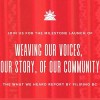CFNet Petitions Trudeau Government to Grant Caregivers landed Status on Arrival
(In support of CanadianFilipino.Net’s Community Campaign for Caregivers, Dahong Pilipino is honored to reprint below, CFNet’s petition requesting Prime Minister Justin Trudeau to grant landed status to caregivers on arrival instead of treating them as temporary foreign workers. Although the Live in Caregiver Program was discontinued in 2014, there are about 24,000 Filipino caregivers and their families who are still struggling to attain permanent residency and a secure future in Canada. Many of them are working as frontline workers now to make Canadians safe from Covid-19. Their service and healthcare work is essential and should be valued for what they are worth.
Please send copies of the Dear PM editorial and the Commentary or links to these documents to the PM’s office and to the IRC Minister for their consideration.
Maraming salamat for your support – Dahong Pilipino
NEWS
CFNet Petitions Trudeau Government to Grant Caregivers landed Status on Arrival
By Eleanor R. Laquian
July 16, 2020 – In a community campaign for landed status for caregivers on arrival, Canadian Filipino Net urges its readers and supporters to send copies or the links to a CFNet Dear PM editorial and a supporting document to go with it (published on March 16, 2020 and reprinted below) to the Prime Minister and the Immigration Minister for consideration. Please email or mail them (no stamps necessary) to the following:
PM Trudeau
https://pm.gc.ca/en/connect/contact
Immigration, Refugees and Citizenship Minister Marco Mendicino
Marco.Mendicino@parl.gc.ca or Minister@cic.gc.ca
It is hoped that by flooding the offices of the PM and the Immigration Minister with this request, they will eventually right a wrong that has been done to caregivers who were desperate enough to immigrate to Canada under the shortsighted Live-in Caregiver Program (LCP).
The LCP separated Filipino mothers from their own children for at least 2 years to take care of Canadian children and senors. However, because caregiving was undervalued and low paid, it took almost all caregivers five to ten years to become permanent residents and save enough to bring their family to Canada. Immigration officials who prepared the Live-in Caregiver Program did not foresee the problems such a separation would cause in Filipino homes. Forced separation weakened the Filipino family resulting in marriage break downs, maladjusted children, dysfunctional families and broken homes. But for over 50 years Canada benefitted from the cheap and quality labour of caregivers and temporary foreign workers.
It is now time for Canada to recognize the contributions of caregivers to Canadian well being with appropriate compensation and benefits. If they are not given the means to lift themselves out of their low-income status, they and their children will not have the better future they sacrificed to find in prosperous Canada. To give them upward mobility it is necessary to reclassify caregiving into a skilled job category with landed status on arrival. The service and health care jobs that Filipinos do in Canada is essential work and need to be valued for what they are worth.
_____________________________________________________________________________________
Dear PM Editorial
Domestic Workers and Caregivers’ Plight: An Urgent Women-Equality Issue
Dear Prime Minister Trudeau,
Citizens of the world recently commemorated International Women’s Day. We reminisced on “the story of women’s struggle for equality” and celebrated the many achievements of women realized over a century since this special day began in 1911. When we reflected on what else calls for accelerated action on equality for women, one long outstanding issue pierced this Editorial Board’s consciousness. Namely, the second-class treatment by Immigration and Citizenship Canada of foreign domestic workers and caregivers, nearly all of whom are women of color from developing countries and more than 90 percent from the Philippines.
We, therefore, beseech you to issue a specific ministerial mandate – a policy path to immigration and citizenship that is anchored in fairness for foreign domestic workers and caregivers, most of whom are women.
A. Timeless Story of Women-Inequality
Allow us at this juncture to share with you a story from one group of Canadian live-in caregivers. The Filipino Domestic Workers Association of Manitoba (FIDWAM) which celebrated its silver anniversary in 2013. On that occasion, its President, Gloria Magpali, echoed in her opening remarks the collective memory of their membership, how their “lives were a constant struggle” (FIDWAM’s 25th Anniversary: A Touching Human Story by columnist Dr. Rey Pagtakhan in Winnipeg’s Pilipino Express, September 16-30, 2013). Dr. Pagtakhan – a former Canadian Member of Parliament and senior cabinet minister and now a regular contributor to Canadian Filipino Net online publication – had printed in full in his column Magpali’s remarks and, thereby, captured in the caregivers’ own words their collective sentiment:
“Tonight’s celebration brings to memory our sense of isolation, low esteem and apprehension 25 years ago when we felt alone and on our own for our existence and survival; when we continually heard the comments that we do the job that others do not want to do; when we felt being at the mercy of our employers and under constant fear of deportation; and when we began to be more acutely aware that, by the nature of our job and its status, we were easy targets for the violation of our dignity and human rights.
“Despite our collective apprehension and, sometimes, outright fear, we resolved: to work harder and live up to our employment contract obligations; to remain stronger in our belief that we were doing an essential job for many Canadian families – caring for their young children and aging parents and attending to those with special needs and their other household chores; to remind ourselves that we could send to our families back home the needed funds for livelihood and education; to console ourselves that we were providing a valuable human resource in Canada and contributing to the economic growth and development of our country of birth; and to keep re-assuring ourselves that one day, with God’s help, we would all be Canadian citizens.
“Twenty-five years ago our lives were a constant struggle. Now…We are proud and confident of who we are, what we stand for, and what we are able to be.”
Why Caregivers’ plight is a women-equality issue?
Many of these care workers,98 percent of whom are women, are highly qualified and available to meet Canada’s labour force needs, now and in the future. (See related article in this issue titled: Foreign Domestic Workers and Caregivers: Able and Available to Meet Canada’s Labour Force Needs). Has Canada been fair to them?
Under the Live-in Caregivers Program (LCP) which started in 1992, these domestic workers and caregivers only qualify for temporary employment visas for a limited period and only on condition they retain domestic employment. These conditions are restrictive and make them vulnerable to exploitation and abuse by some employers and recruiters. They leave them no avenue or very limited option for progress even after fulfilling their contract of employment. All these notwithstanding their qualifications.
Yet, these LCP applicants would easily score 67 points or higher out of 100 to qualify under Canada’s Point System for immigration under the Federal Skilled Worker Program were they to be evaluated on the basis of skills, education, language ability, work experience and other factors such as age. This Skilled Worker Program admits a sizable number of male-applicants. Sadly, foreign domestic workers and caregivers, most of whom are women, cannot access this Program. Therein lies the gender inequality, not too obvious at first glance but very real.
Cycles of pilot projects have been adopted by Immigration Canada, with honest intentions we could accept. But the consequential gender-inequality to women has remained unresolved.
Gender-Parity for foreign caregivers is in your hands, Prime Minister
We have noted the progress your leadership has made in advancing gender equality in Canada on many fronts. We remember your historic statement, “Because it’s 2015.” That singular answer – beautiful in its simplicity and teeming with a deep sense of fairness – more than assured the women of Canada. Not only did you create Canadian history; you inspired a nation committed to fairness and human decency for women – a source of pride and inspiration for all nations and a source of joy for all women of the world.
Precisely because of your humanity-based leadership that we find it difficult to understand that compassionate Canada has changed for the worse with respect to how our recent waves of domestic workers and caregivers have been treated.
We believe, Prime Minister, you would help foreign domestic workers and caregivers achieve their cherished dream of: “one day, with God’s help, we would all be Canadian citizens.”
May you allow those who are already here to become permanent residents and allow future applicants to come to Canada as regular immigrants with permanent resident status on arrival and able to pursue options after fulfilling their entry employment contracts. Because they provide an essential service to the rapidly increasing number of ageing Canadians, the processing of their applications as regular landed immigrants should be expedited so that they arrive in Canada within two years upon filing the papers. Their future is in the hands of your leadership.
The CanadianFilipino.Net Editorial Board
Contact us at info@canadianfillipino.net
(CanadianFilipino.Net is the nationwide twice-a-month online magazine for and about Canadian Filipinos to inform, engage, dialogue, facilitate interaction and connect Filipino communities from coast to coast. It is published by Maple Bamboo Network Society, a non-profit, and run by an all-Filipino volunteer staff.)
___________________________________________________________________________
A Commentary on Caregivers and Immigration
Foreign Domestic Workers and Caregivers: Able and Available to Meet Canada’s Labour Force Needs
March 16, 2020 –To celebrate International Women’s Day this year, thousands of women took to the streets in major urban centers including Toronto and Vancouver demanding gender equality and proclaiming women’s rights. These marches called to global attention the fact that there’s still a lot to be done to advance women’s rights all over the world including Canada where undervalued women do housework and provide child and elderly care daily in Canadian homes.
Female Family Members as Caregivers
- In general, female family members –wives, mothers, grandmothers to aunts, nieces, sisters – do a lot more housework and caring for the young and old than any male member of the family. (See our Editorial on this topic in May 2020.)
- These home builders and caregivers do all they can –inside and outside the home – for the good of the family. Their work is endless, their sacrifices innumerable, their patience immeasurable, their love unconditional and endless. Their reward: love and affection, honor, respect and pride in the family’s achievements.
Foreign Domestic Workers and caregivers in Canadian Life
- Foreign caregivers and domestic workers have been coming to Canada for over a hundred years. In the 1800s, European women came to be household helpers. There were no restrictions on their becoming permanent residents or citizens in Canada. In fact, they were invited to immigrate and become full pledge Canadians.
The last half century has seen the change of source countries for this vital labour force. Canada’s Foreign Domestic Movement (FDM), established in 1981, targeted Caribbean women primarily and its successor, the Live-in Caregiver Program (LCP), started in 1992, attracted Asian women. Both groups are women of color and are not given as easy an access to permanent residency as those European women before them who came to do the same work.
A. Current demographic characteristics of caregivers
An updated study of caregivers and domestic workers in Canada shows their current characteristics:
1. The educational level of LCP principal applicants has increased steadily over the years, and is now very high.
a. In 2009, 63 percent of applicants held a bachelor’s degree or higher. This is a remarkably high proportion, and far exceeds the proportion of principal applicants in ‘economic’ categories of immigration who have university degrees (39.5percent). [CIC Facts and Figures, 2009: p42].
b. From 1993 to 2009, 444 principal applicants had Masters degrees and 48 had earned doctorates.
2. The majority of principal applicants are aged between20-40.
3. Principal applicants are more likely to be married.
4. The overwhelming majority are women.
5. Over 90 percent have come from the Philippines and are proficient in English.
B. From the lens of the Federal Skilled Worker Program.
If the LCP applicants were evaluated under Canada’s Comprehensive Ranking System (CRS) or Points system based on skills, education, language ability, work experience and other factors such as age, most would easily score 67 points or higher out of 100 to qualify to immigrate in Canada under the Federal Skilled Worker Program.
C. Needs and Socio-Economic Implications of Canada’s Ageing Society
1. With low fertility rates and more Canadian couples getting married at a later age, the number of those who are 65 years or older are expected to double in less than two decades from 5.0 million to 10.4 million in 2036.
a. In 2014, over 6 million Canadians were aged 65 or older, representing 15.6 percent of Canada’s population.
b. By 2015, 1 in 4 Canadians were 65 years and older. For the first time, there were more Canadians over the age of 65 than under the age of 15.
c. By 2030 – in just 10 years from today – seniors will number over 9.5 million, making up 23 percent of Canadians.
2. The greying of Canada’s population carries the following socio-economic implications:
a. increasing need for caregivers;
b. less revenue for government; and
c. rising healthcare costs.
A 2002 study conducted by Health Canada found that 44% of family caregivers paid out-of-pocket expenses; 40 percent spent $100 to $300 per month on caregiving, and another 25 percent spent in excess of $300.
3. The costs of caring for aging parents:
a. The cost of elderly care amount to $33 billion a year in out-of-pocket expenses and time taken from work, and are expected to grow (according to a report by CIBC economists);
b. average cost of $11,635 for those 65 increases to as much as $21,150 for those 80 and older. (according to the Canadian Institute for Health Information (CIHI);
4. In Canada, the government only pays 70 percent of healthcare costs. The other 30 percent is left for seniors or their family members to pay.
5. After the age of 65, Canadians expect to spend an average of $5,391 every year on out-of-pocket medical expenses. Family caregivers spend an average of $3,300 a year on these expenses.
6. Family members who cared for ailing children or older relatives reported more health and psychological problems, mainly because of the intensity of care provided. Those who cared for an ailing spouse also experienced financial difficulties as a result of their caregiving responsibilities and loss of spousal income.
7. Without caregivers employed by families to look after their ailing spouse or parents and grandparents, the government will have to spend billions of dollars to provide institutional care where needed. Even at that, most nursing homes have been found by families to be wanting – lack of competent and fulltime staff, poor medical support and poor hygienic conditions.
D. Consensus
1. The best place for ailing old people is at home in the compassionate care of competent caregivers privately and partly paid for by the government through subsidies and special grants where warranted, and supervised by family members.
2. This is how the government can ensure the proper care of Canadian seniors and at the same time save money in institutional care and health care costs.
3. Also, this approach would generate more revenue for the government because more women will be able to work outside the home.
4. The services provided by foreign domestic caregivers and workers are essential and the need for them will be heightened with the rapidly increasing number of ageing Canadians.
5. The Philippines has been the dominant source of foreign domestic workers and caregivers (not only for Canada but also for the US, Spain Israel, etc.) because Filipino caregivers are well educated, have facility with one of Canada’s official languages (English), share similar cultural and religious values, committed to hard work and industry, and imbued with a deep sense of caring for others.
6. Indeed, foreign domestic caregivers and workers, most of whom are women, are able and available to meet Canada’s labour force needs, now and in the future.
E. Conclusion
Although the LCP was discontinued in 2014, there are about 24,000 caregivers and their family members who came under this program and who are still struggling to get permanent residency, reunite the family and secure a decent future in Canada. Due to certain restrictions of the LCP, years of family separation have caused familial conflicts between alienated caregiver-mothers and their estranged children resulting in family breakdowns and marriage failures.
These caregivers and their family members have suffered long enough. The current immigration pilot projects are mere bandaid-type solutions to LCP-caused problems and only prolong their uncertainty and insecurity. It is time for this social injustice to end.
These care workers should be allowed to become permanent residents without making them jump through hoops. This is the only just solution to this social injustice – landed status now.
Because they are qualified as skilled workers, future caregiver applicants should be admitted as regular immigrants with permanent resident status on arrival and with the same right as other immigrants to seek a better life and a brighter future for their children in Canada.
Because they provide an essential service to Canadian families where both parents work and to the increasing number of ageing Canadians in need of competent, compassionate and relatively affordable and flexible care, the processing of caregivers applications as regular landed immigrants should be expedited so that they arrive in Canada within two years upon application.
These caregivers come from poor developing countries and do not have the luxury of time. They cannot afford to wait three to five years before landing a job when their work is in demand in Canada. Giving them the opportunity to improve their future would truly advance all women’s rights in Canada and show appreciation of their work and contribution to Canada’s development.
_________________________________________________________________
 Canada
Canada









